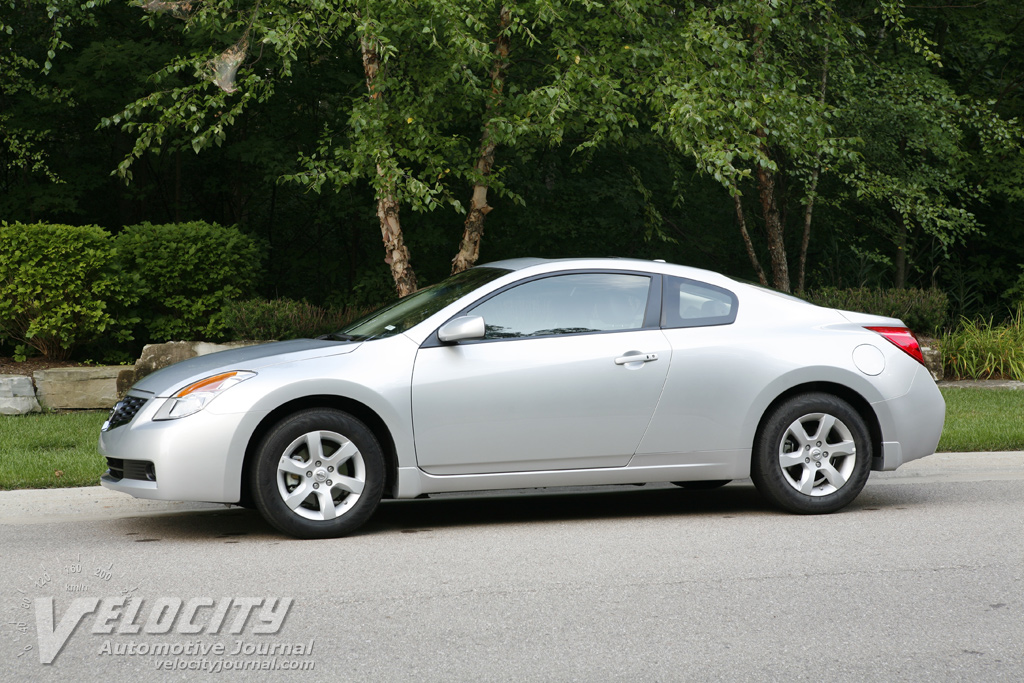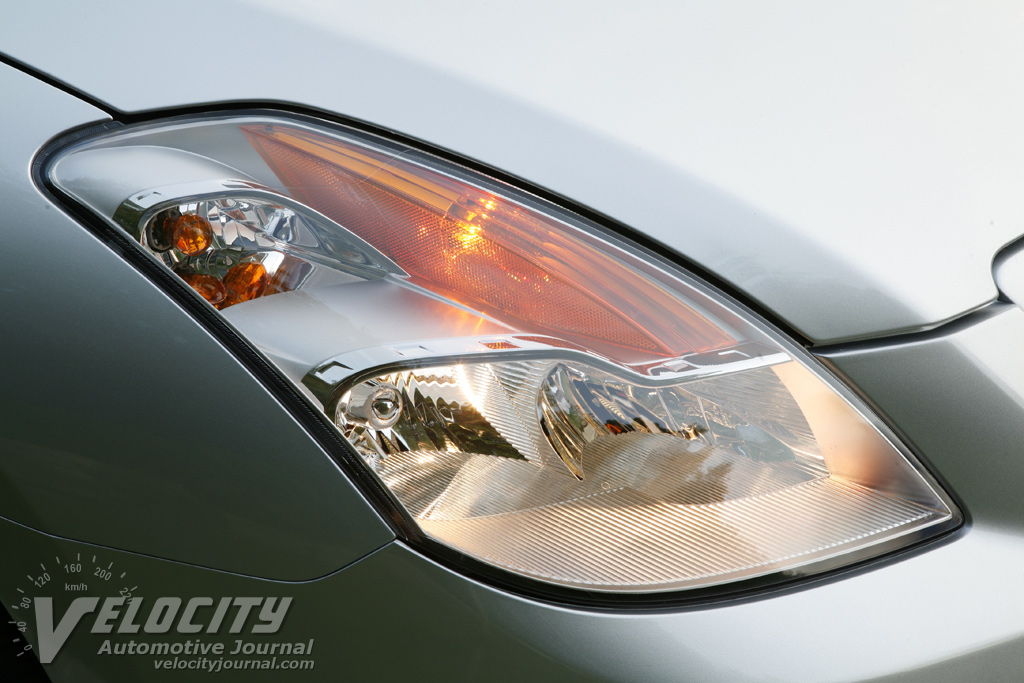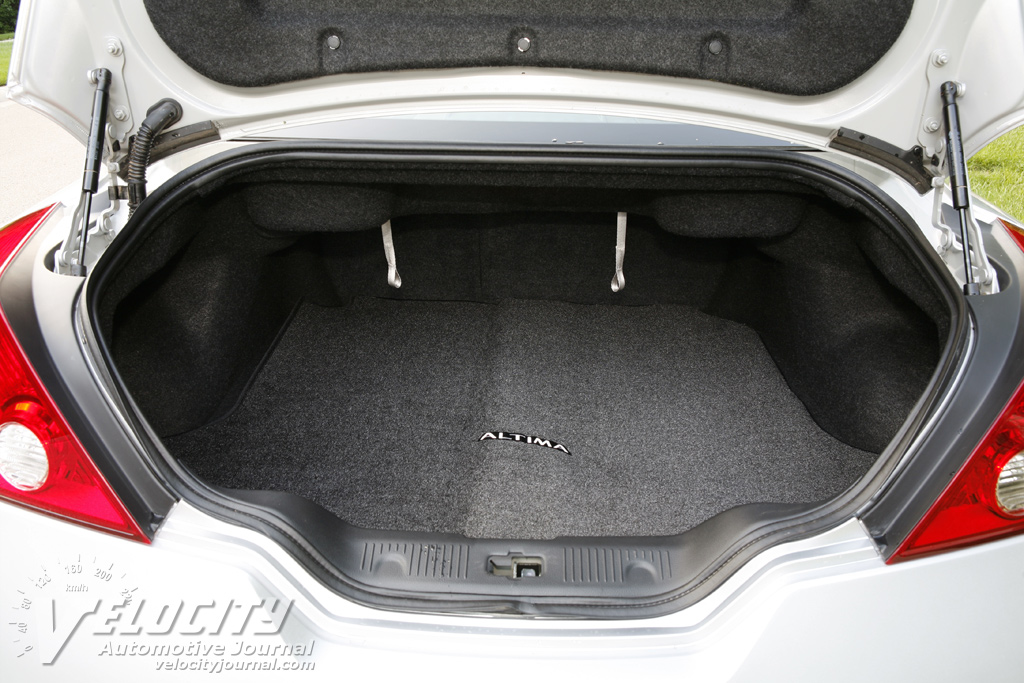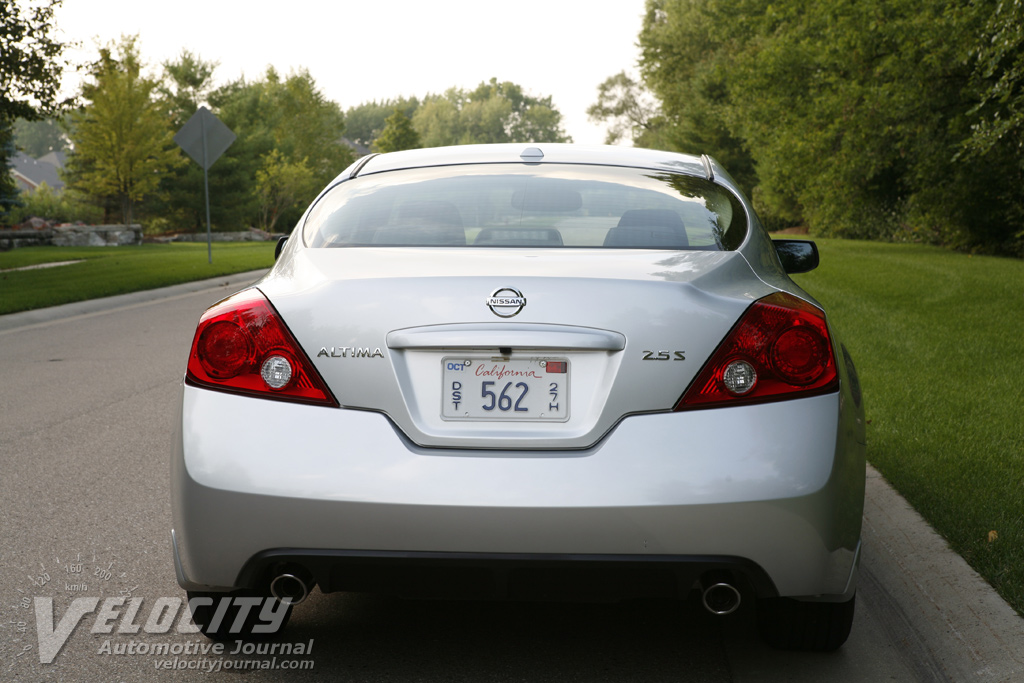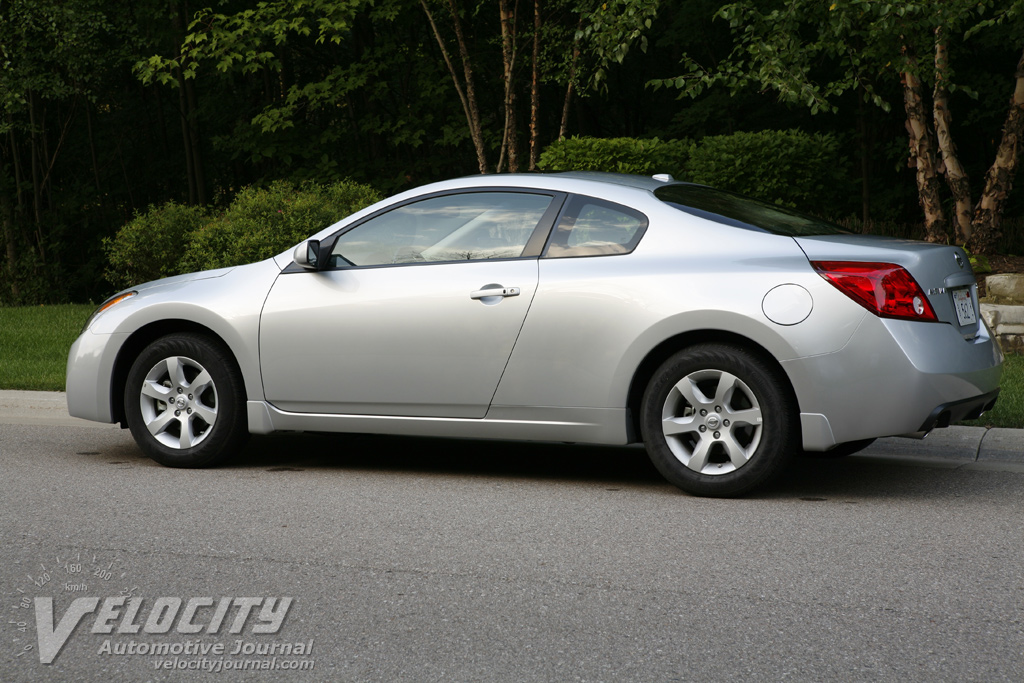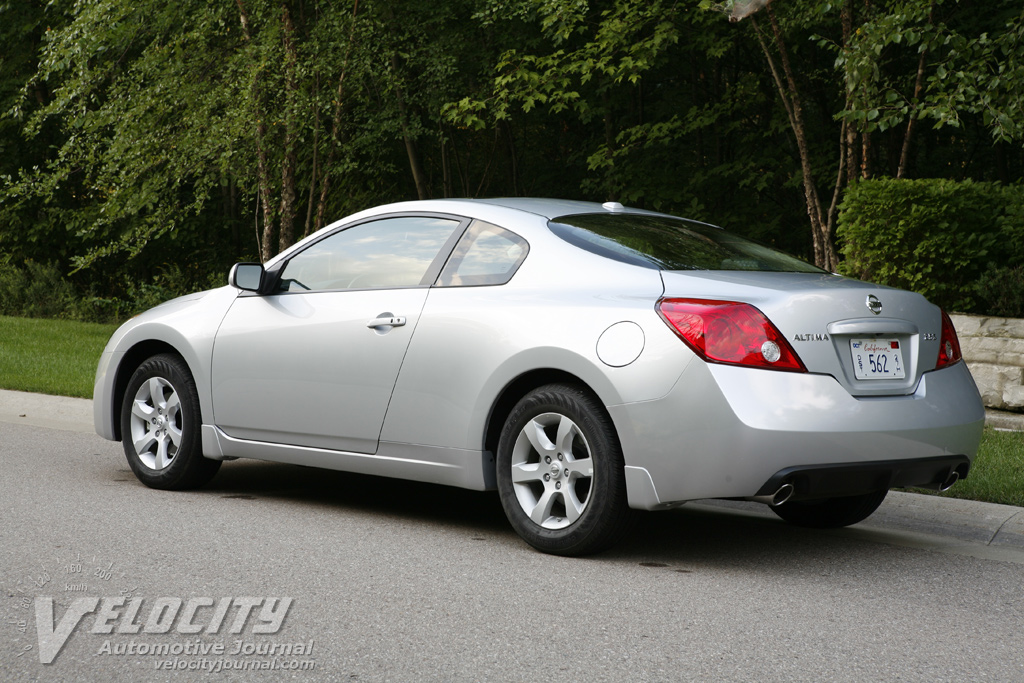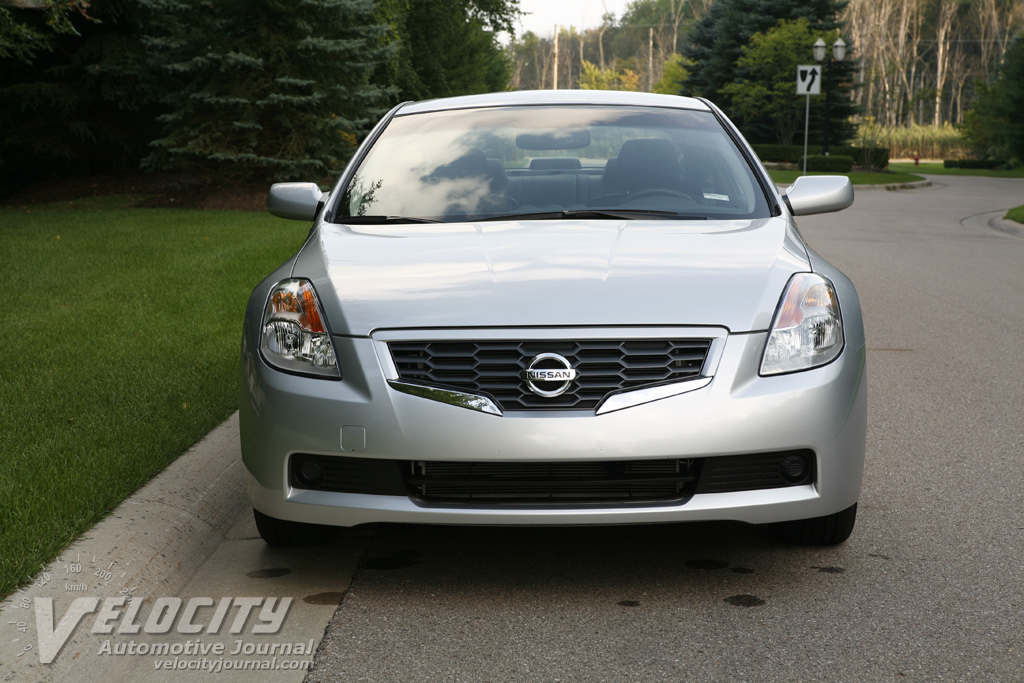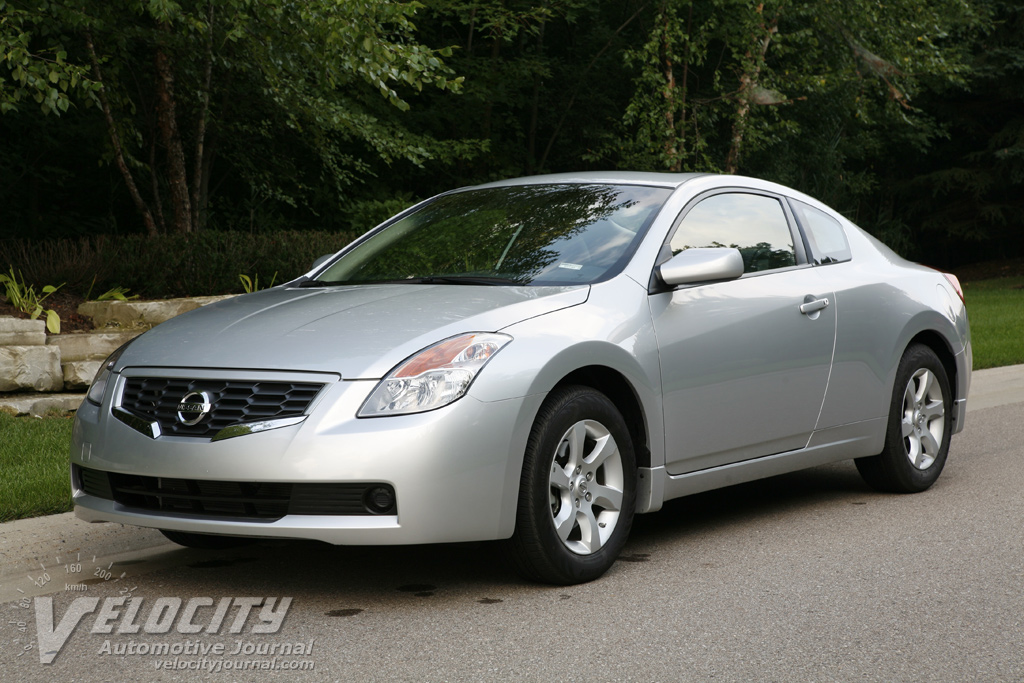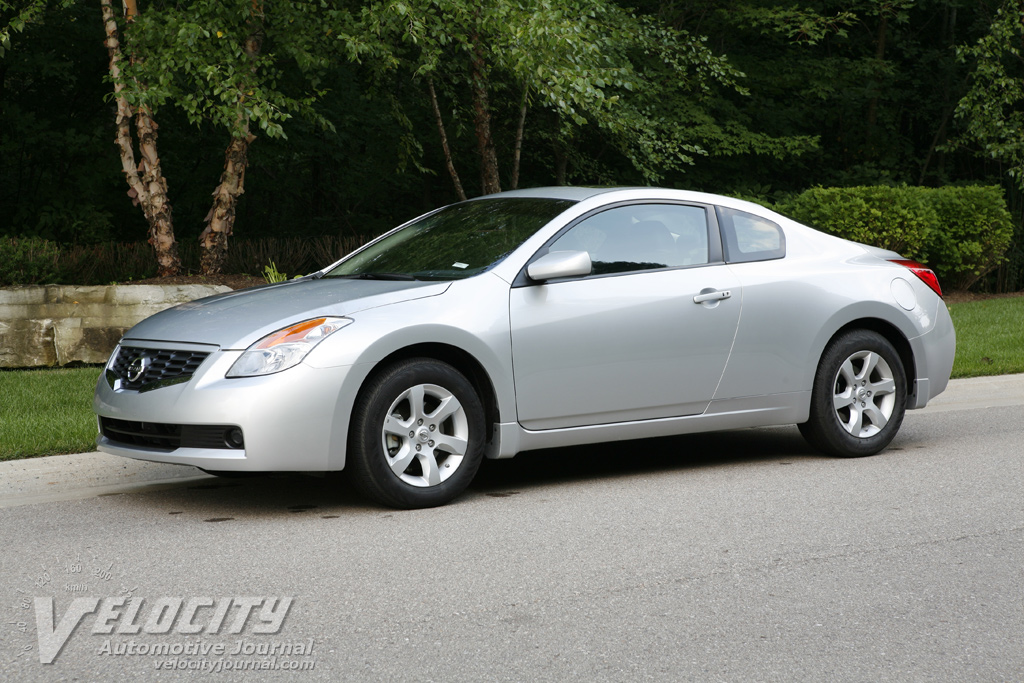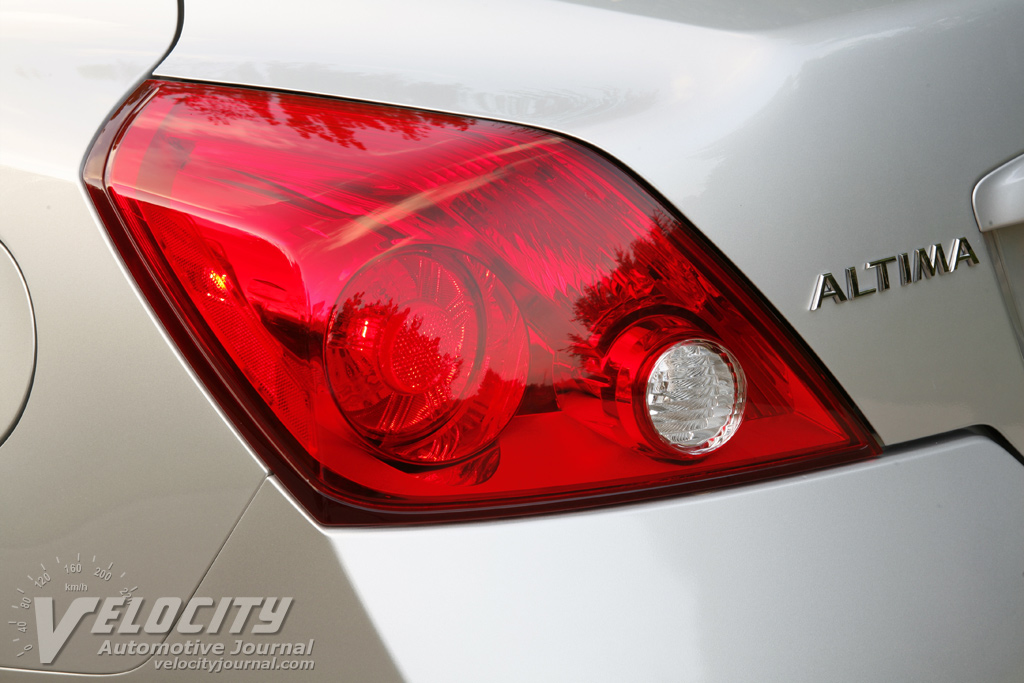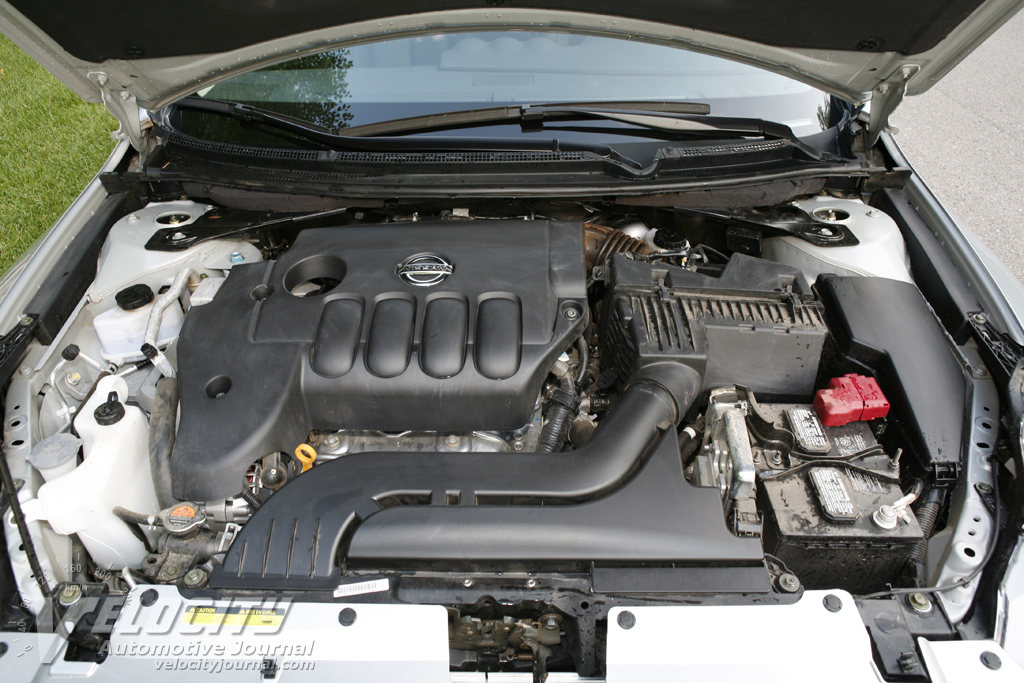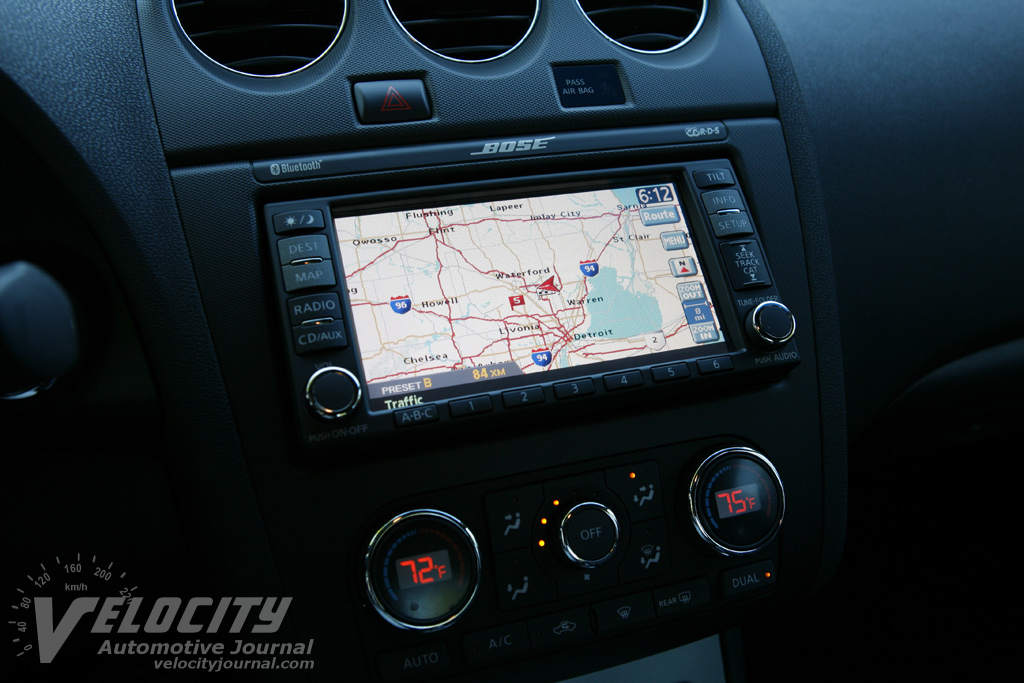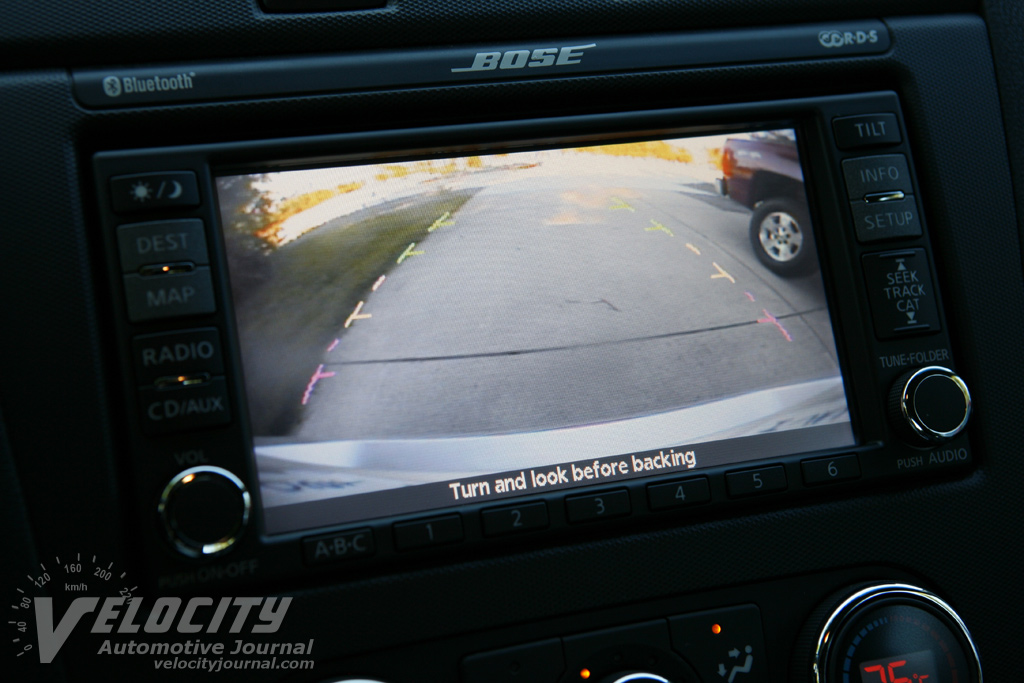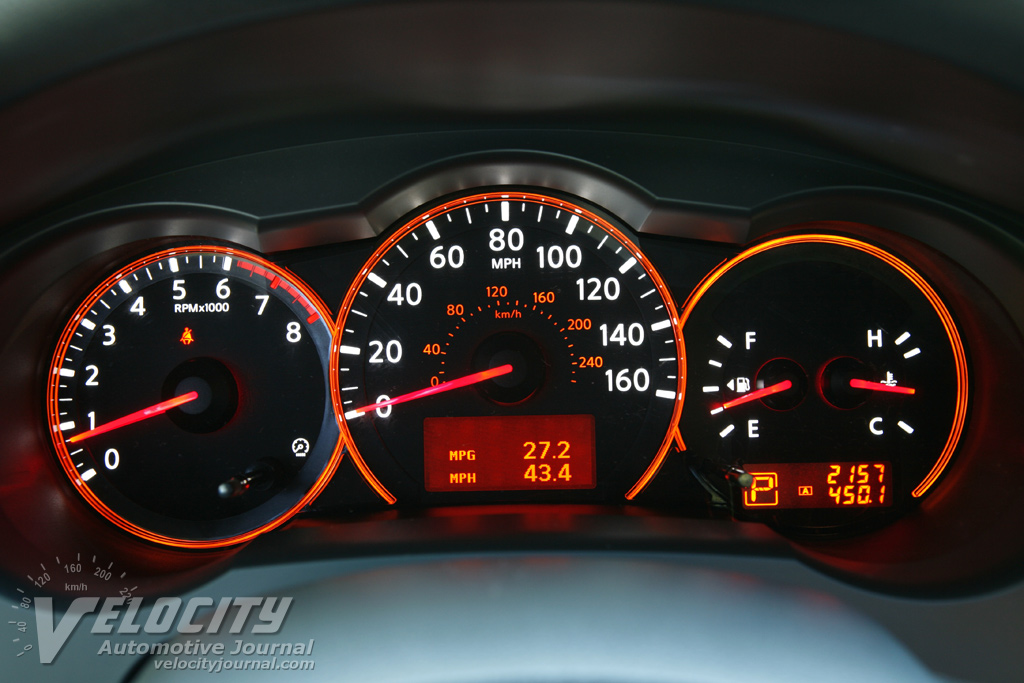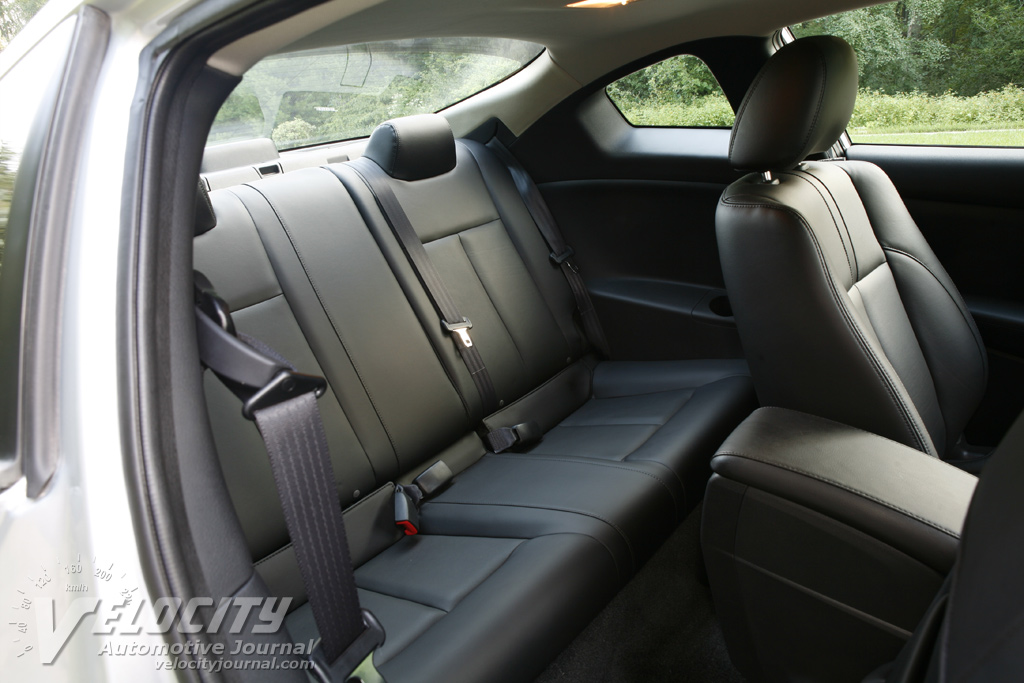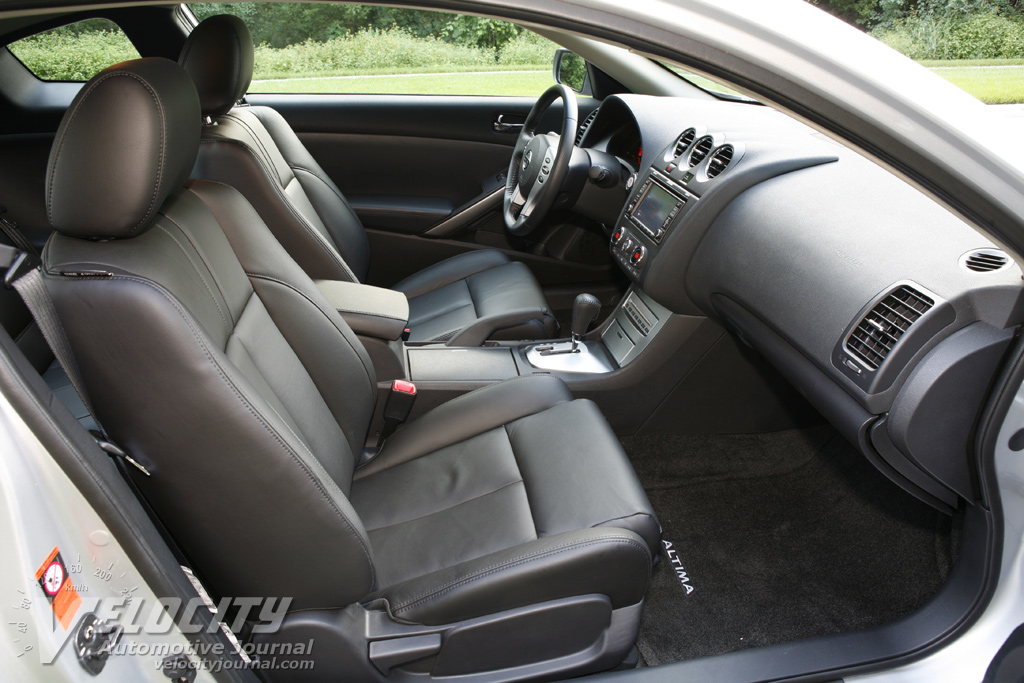2008 Nissan Altima Coupe 2.5 S
08/27/2007
Shahed Hussain
The sporty Altima is Nissan's best-selling vehicle (easily outstripping the Sentra by a more than 2-to-1 margin), so it seemed logical to derive a new coupe from its popular "D" platform sedan. To separate the 2-door Altima from its more practical sibling, Nissan revamped the styling to reflect its mission as a true 2+2 coupe, resisting the temptation to create a sedan missing a couple of doors. The Altima Coupe has a 4.0-inch shorter wheelbase, and overall length of 182.5" is a substantial 7.4" shorter than the sedan. The coupe roofline stands at 55.3", or 2.6" lower than the 4-door; while overall width remains the same at 70.7". The more compact exterior dimensions, as well as its unique styling help separate the Altima Coupe from its larger sibling.
Most manufacturers have found the affordable coupe market to be rather volatile, with sales often dropping off dramatically a few years after a new model is introduced. Honda, Toyota, and Mitsubishi have remained in this segment despite the low production volumes. Although the popular Ford Mustang is in the same price range as the Altima Coupe, it appeals to an entirely different demographic. The Altima Coupe's real competition comes from the Honda Accord Coupe, Mitsubishi Eclipse, and to a lesser extent, the Toyota Camry Solara and Hyundai Tiburon.
Nissan offers the same powertrain choices for the Altima Coupe as for the sedan: a 175-bhp 2.5L I-4 or a 270-bhp 3.5L V6. Both engines can be mated to a 6-speed manual or a CVT automatic. We tested an Altima Coupe 2.5 S equipped with the CVT ($20,990), Premium Package ($5,100), Technology Package ($2,000), and floor mats/trunk mat ($175). The grand total including $615 destination charge was $28,880.
Since we lean towards maximum performance for the money, we would equip the Altima Coupe quite differently if we were buying one. For the enthusiast on a tight budget, the standard 6-speed manual saves $615. We would ditch the expensive Premium and Technology Packages, and substitute the $1,300 Convenience Package with 16-inch alloy wheels, 8-way power driver's seat, leather-wrapped steering, and steering wheel audio controls instead. As a final touch, the aluminum Kick Plates ($85) are a pretty good deal. Our preferred 4-cylinder Altima Coupe would be a wallet-friendly $22,675 including destination.
On the other hand, if we had around $29K to spend, then the Altima Coupe with 3.5L V-6, 6-speed manual transmission, and optional Vehicle Dynamic Control ($600) would be our choice. Add the $3,200 Premium Package (HID headlights, Bose® audio system, and heated leather seats), floor mats/trunk mat, and aluminum kick plates for a total of $29,575 with destination charges. For only $695 more than our test vehicle, a lightly optioned Altima Coupe 3.5 SE is a decidedly superior alternative. Granted, the V-6/6-speed powertrain gets only 27 MPG on the highway vs. 31 MPG for the 2.5L/CVT combination, but we think that the superb 270-bhp VQ35HR is well worth the slight fuel consumption penalty.
All Altimas benefit from a standard push-button engine start system that engages if the driver has the remote key fob in possession. The remote also allows keyless entry: press a button on the door handle, and the Altima will unlock the driver's door, or both doors. A multi-function LCD controls the navigation and the Bose® audio system. The navigation system interface uses mostly tiny touch-screen buttons scattered all over the display. Unfortunately, the on-screen buttons lack tactile feedback, which limits navigation system usability while driving. As is typical from Bose, audio quality from the 9-speaker, dual-subwoofer system was superb, with crisp treble, tight bass and plenty of wattage. The Bose system also has MP3/WMA/XM satellite radio capability. Navigation system-equipped Altimas have the 6-CD changer and the external line-in jack relocated lower on the center console, which is less convenient than its normal location near the top of the center stack. Dual-zone climate controls have large chrome-ringed knobs to adjust temperature, and a smaller center knob for fan speed.
Both the Altima Coupe and the sedan share common interior design elements: the dashboard and steering wheel are identical. However, the Altima Coupe gets unique sport seats with 6-way power control for fore/aft adjustment, rake, and height, as well as manual lumbar support for the driver. The front passenger seat has 4-way manual control only. We found the seats supportive, with effective bolsters that kept us firmly in place. Our test vehicle had a charcoal interior, with contrasting silver trim on the center console, steering wheel and door panels. Most interior panels are soft-touch plastic, with the exception of the center console. The leather-wrapped steering wheel has integrated audio and cruise controls on the spokes.
As in most 2+2 coupes, rear seat accommodations are less than ideal. Although the folding seats are comfortable for two passengers, with reasonable legroom, the sloping roofline severely restricts headroom. Passengers taller than 5'-8" will find their heads touching the backlight, requiring them to sit forward to gain a few inches of extra headroom. Raising the roofline a couple of inches would alleviate this problem, but at the expense of the Altima's sleek coupe profile.
The 2.5-liter QR25DE fulfills its mission as a base powerplant, but the long-stroke inline-4 doesn't rev willingly. Idle boom was noticeable on cold starts, but disappeared once the engine warmed up. An abbreviated 6,200 RPM redline eliminates any opportunity for high RPM thrills. Although 175-bhp @ 5,600 RPM and 180 lb.-ft. @ 3,900 RPM are certainly adequate, the QR25DE is capable of significantly more power. In the Sentra SE-R Spec-V, the same engine achieves a more impressive 200-bhp @ 6,600 RPM and 180 lb.-ft. @ 5,200 RPM. Part of that power gain is due to its higher 10.5:1 compression ratio, which requires premium fuel. However, we suspect that this higher state of tune is less than ideal for the heavier Altima and its optional CVT. Besides, Nissan probably assumes that enthusiasts will gravitate towards the 270-bhp 3.5 SE anyway, while the 2.5 S is aimed at more price-conscious buyers.
Even though we prefer manual transmissions, the optional CVT automatic does have its appeal. Leave it in Drive and the CVT seamlessly changes ratios to maximize acceleration or fuel economy. At part throttle, the inline-4 revs to about 2,000 RPM as the CVT changes ratios to accelerate smoothly to speed. Mash the gas pedal, the revs rise to 6,000 RPM (just past the 5,600 RPM power peak), and the Altima lunges forward, but without the customary wheelspin or jerkiness expected from a manual transmission or even a conventional torque converter automatic. Nonetheless, the CVT in full automatic mode just doesn't feel that sporty. The picture changes radically if you slide the transmission lever into the manual shift gate: now the CVT holds a simulated "gear" right up to the 6,200 RPM redline, and won't upshift without driver input. The Altima feels lively, and the engine seems more responsive in manual mode. To keep the engine from stalling, the CVT will downshift at low speed if required. The 2.5-liter/CVT combination is EPA rated at 23/31 MPG (city/highway). We averaged 25 MPG in mixed city and highway driving.
Nissan tuned the Altima Coupe's suspension for a fine balance of ride and handling. Around curves, the chassis stays flat and planted; dive and squat are minimal. Over bumpy roads, the ride becomes slightly jiggly, but not uncomfortably so. On concrete-surfaced roads, the aggressive tread on the Continental ContiProContact tires is noticeably noisy at highway speeds, but quiets down considerably on asphalt. The chassis could easily handle more power than the 2.5L engine can deliver, which isn't surprising since the optional 3.5L V-6 delivers considerably more horsepower. Front suspension components consist of struts/coil springs, while the rear uses a multi-link/coil spring setup. Stabilizer bars are standard at both ends.
Braking duties are handled by a standard 4-wheel disc system: 11.7" diameter front rotors and 11.5" diameter rear rotors. ABS, EBD (Electronic Brake force Distribution), and Brake Assist are standard. VDC (Vehicle Dynamic Control) is optional on V-6 Altimas. The firm brake pedal provides above average feel, and slows the Altima with no drama. Steering assist is vehicle speed-sensitive, and is moderately weighted regardless of speed. Kickback through the wheel is minimal, but the steering feedback seems to be somewhat filtered out.
We really enjoyed driving the Altima Coupe. We think the 2.5L engine would be considerably livelier with the 6-speed manual, but given our preferences, the 270-bhp V-6 is almost mandatory in this sporty coupe. Despite its relatively limited market appeal, the Altima Coupe should attract young, relatively affluent customers who may not be able to justify purchasing the more expensive and tightly focused 350Z. With pricing that starts just above $20K, the Altima Coupe 2.5 S is aimed directly at the 4-cylinder variants of the Honda Accord Coupe and Mitsubishi Eclipse, both of which are entrenched competitors in the FWD coupe segment. We think that the Altima Coupe is a credible alternative to its Japanese rivals, and a welcome addition to Nissan's lineup.

